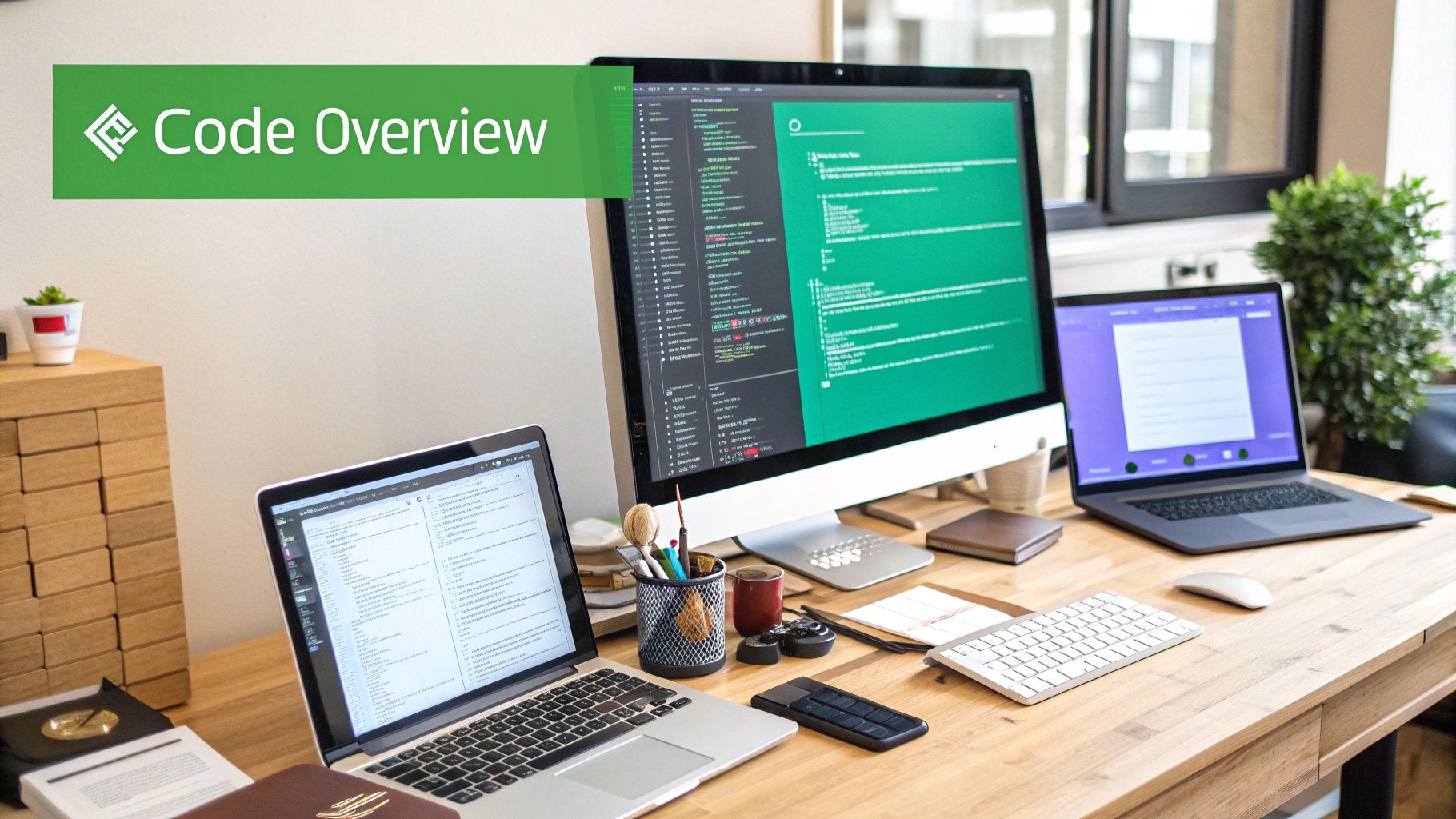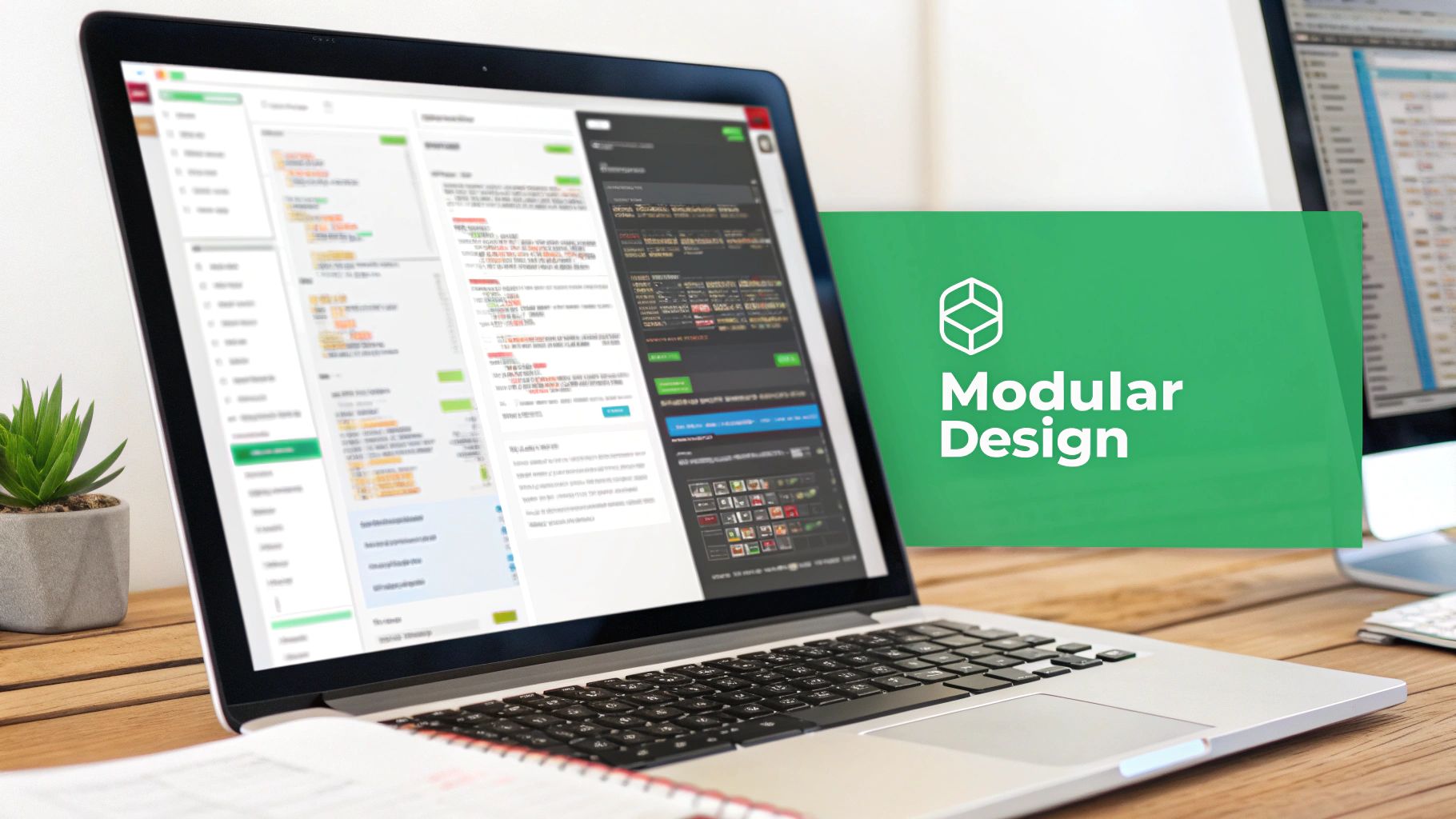Master modern code quality assessment with proven developer-tested metrics and strategies. Discover actionable insights from engineering leaders on measuring, improving, and scaling code quality that delivers business value.

Good code quality goes far beyond just fixing bugs. It’s about creating software that works well now and can be easily maintained in the future. Smart teams know they need to balance technical excellence with practical business needs when measuring and improving their code.
High-quality code has several essential traits. Maintainability means developers can easily update and debug the code - think of well-organized code with helpful comments versus a messy jumble of functions. Reliability is about code that performs consistently without unexpected errors. Like a well-built house, code needs scalability - the ability to handle more users and features without breaking down.
Teams use both subjective and data-driven ways to check code quality. Code reviews help spot issues like confusing variable names that make code hard to read. For concrete measurements, teams track metrics like cyclomatic complexity - which shows how many different paths exist through the code. When this number goes above 10, it often signals code that will be tough to test and update. Code coverage tells you what percentage of code your tests actually check. While high coverage is good, remember that even 100% coverage doesn’t guarantee perfect code - the tests themselves need to be solid.
Creating good code starts with building the right team environment. This means having open discussions about code quality, regular review sessions, and clear standards everyone follows. When teams make code quality a priority, they spend less time fixing old problems and more time building new features. The result? Better software that makes both developers and users happy.

Writing quality code isn’t just about functionality - it’s about making it maintainable and understandable for the long term. Let’s explore the practical ways development teams measure and manage code complexity to build better software.
Two key metrics help teams assess their code. First is Cyclomatic Complexity, which counts the number of different paths through a piece of code. Think of it like mapping out all the possible routes - more routes mean the code is harder to test and maintain. The second important metric is Halstead Complexity, which looks at how many operators and operands are used. This helps teams understand how computationally complex their code is.
Thomas J. McCabe introduced Cyclomatic Complexity back in 1976 as a way to measure program complexity. The basic idea is simple - lower numbers mean simpler code with fewer potential bugs, while higher numbers suggest more complex code that needs more testing. Teams use this metric to spot trouble areas in their code before they become problems. Learn more about code quality metrics.
Smart development teams don’t just collect metrics - they put them to work. This means setting realistic complexity thresholds based on their specific needs. A team building medical devices might need very strict limits, while a team working on a quick prototype can be more flexible.
Here are some practical ways teams keep complexity under control:
Getting everyone on board with managing code complexity is crucial. The best teams make these metrics meaningful by:

Testing forms the backbone of code quality assessment. High-performing development teams know that relying on just one type of test isn’t enough - they need multiple testing approaches working together. This combination helps catch issues early and builds more reliable software.
A good test suite needs to do more than check if code works - it should provide actionable feedback that drives improvements. Smart teams design tests that cover normal usage, edge cases, and error conditions. For instance, when testing a login system, you’d want to check:
While thorough testing matters, you also need to keep development moving at a good pace. Chasing 100% code coverage often isn’t practical, especially on fast-moving projects. Instead, focus your testing efforts on:
As your project grows, your testing approach needs to grow with it. Build automated testing into your development pipeline through continuous integration and delivery (CI/CD). This automation lets you run tests frequently and catch problems quickly. Regular testing keeps code quality high and helps prevent old bugs from coming back.

Code quality measurement works best with the right tools and automation in place. Top development teams now rely heavily on static analysis tools, linters, and continuous integration platforms to catch issues early and maintain consistent quality standards throughout their projects.
When selecting code quality tools, focus on what works for your specific needs. Here are the key factors to consider:
A well-designed quality pipeline helps teams catch issues before they reach production. Here’s a practical approach:
Making sense of tool results helps drive real improvements. Here’s how to use the data effectively:
After exploring code complexity measurement and testing strategies, it’s time to set clear quality metrics and standards for your team. This gives everyone a shared definition of high-quality code and establishes measurable goals. By integrating these standards into your workflow, you can help your team consistently deliver better code.
Start with specific benchmarks for your key metrics. For most teams, a good starting point is keeping cyclomatic complexity under 10 per function, though this may vary by project. Many teams aim for at least 80% code coverage in their test suites. Document these benchmarks clearly and make them easily accessible to all team members.
Build quality checks directly into your daily work to help teams meet these standards. Use tools like ESLint and SonarQube to automatically flag code that doesn’t meet your benchmarks. This gives developers immediate feedback while coding, letting them fix issues early. You can also add quality gates to your CI/CD pipeline - for example, automatically failing builds if code coverage drops below your target percentage.
Code reviews are essential for both maintaining quality and helping teams learn from each other. Create a straightforward review process that checks adherence to your metrics and standards. Reviews should verify that code stays within complexity limits and has proper test coverage. Good code reviews don’t just catch problems - they create learning opportunities for everyone involved.
Setting metrics is just the beginning - you need buy-in from your whole team to make quality a priority. Regular discussions about code quality, ongoing training opportunities, and recognition for quality improvements all help build this culture. Some team members may resist new processes or tools at first. Address their concerns by clearly explaining the benefits and providing support during the transition. When everyone understands why quality matters and has the tools to achieve it, you’ll see better results across all your projects.
Code quality measurement is just the beginning. The real impact comes from converting metrics into actual improvements. This needs a clear plan and ongoing dedication to quality standards. Top development teams make quality a core part of their culture with systematic feedback, monitoring, and regular improvements.
A well-designed feedback system helps maintain consistently high code quality:
Good monitoring helps track progress and spot weak points. Key approaches include:
Better code quality comes from repeated improvements: